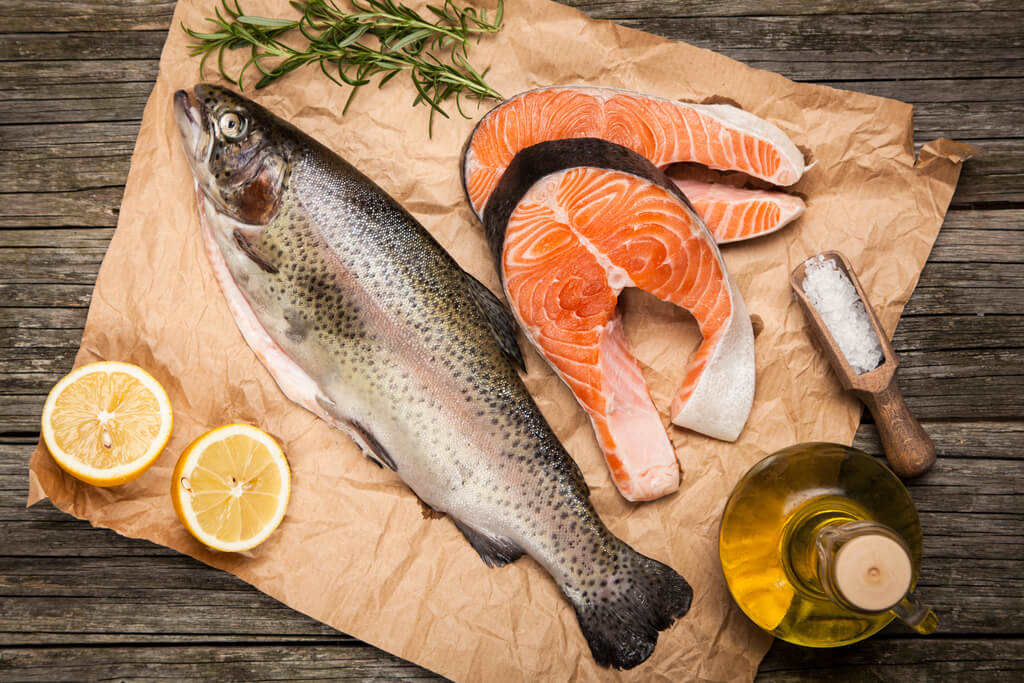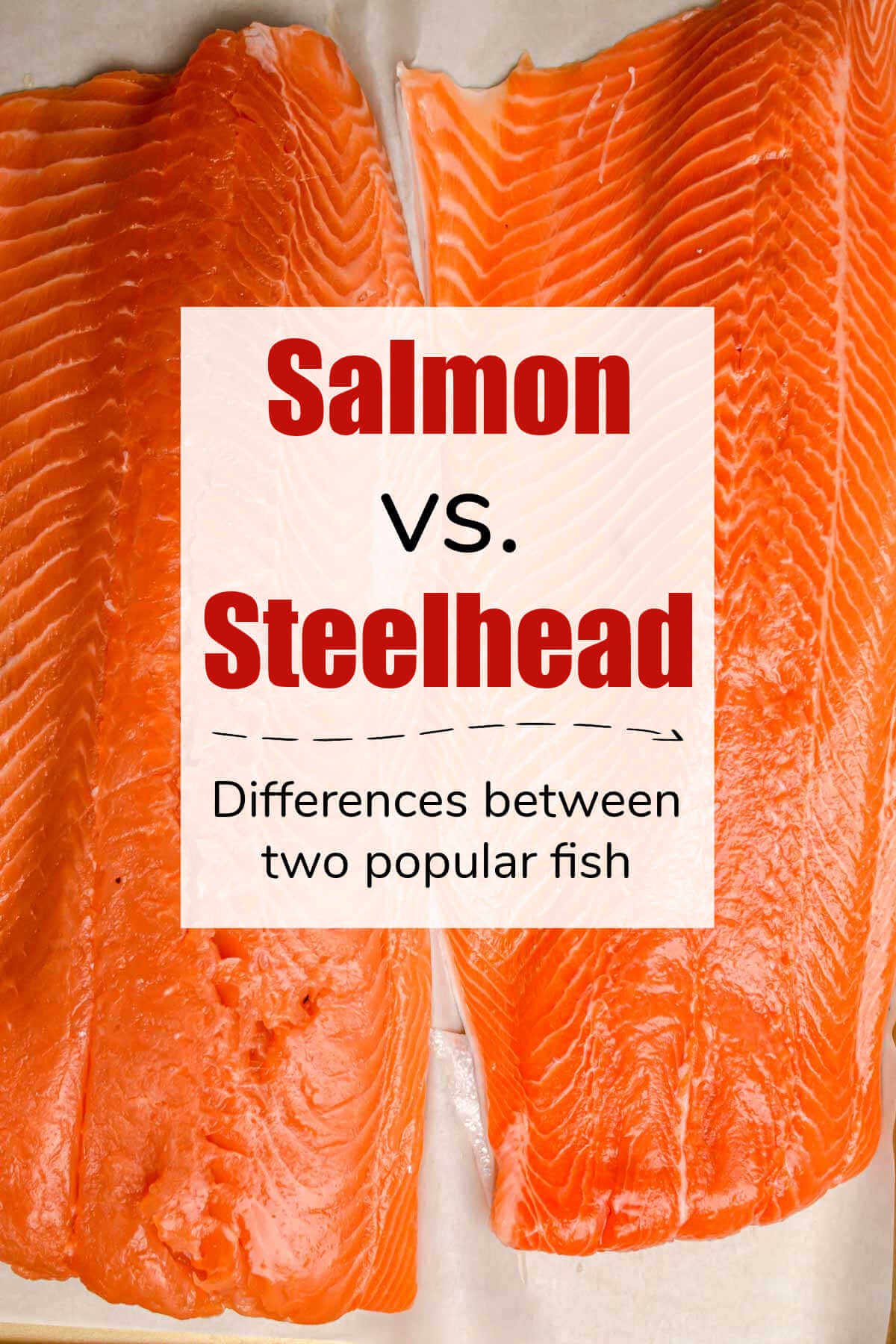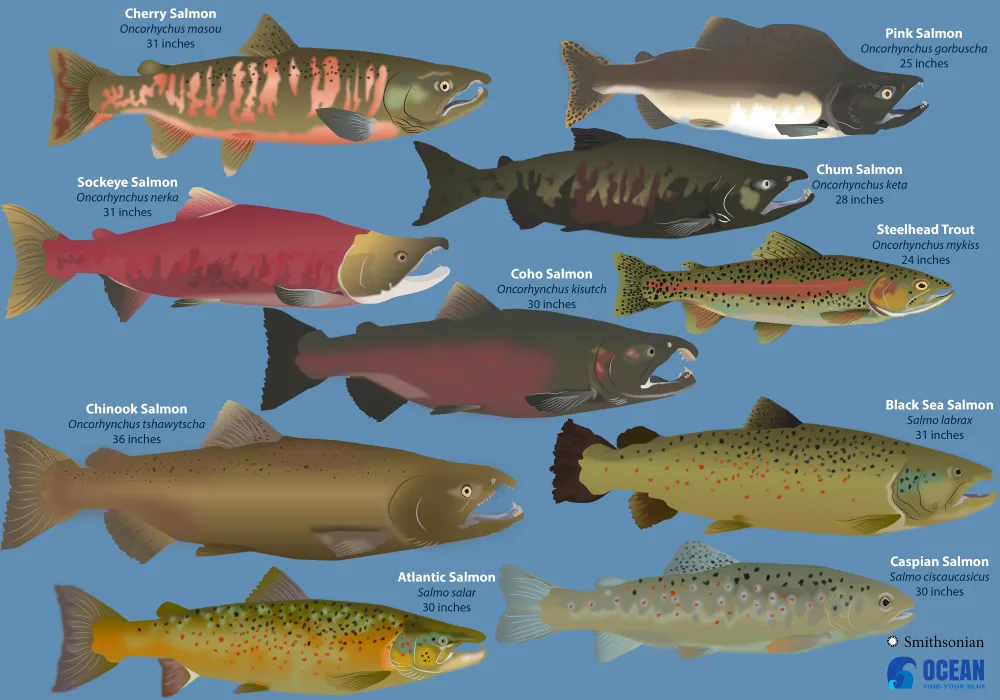Steelhead Trout Vs Salmon: An Overview

When comparing steelhead trout to salmon, it’s important to understand that they are different varieties of fish. While both belong to the Salmonidae family, steelhead trout is the anadromous form of the rainbow trout, while salmon encompasses various species. These fish differ in appearance, taste, habitat, and market price. Despite their distinctions, they share certain behavioral characteristics. Steelhead trout and salmon both exhibit migratory behavior, returning to freshwater to spawn. In terms of health benefits, both fish provide a good source of omega-3 fatty acids. Environmental impact and conservation efforts also play a role in the steelhead trout vs salmon debate.
Steelhead Trout And Salmon: Key Differences
Steelhead trout and salmon differ in several key aspects. First, their appearance sets them apart, with steelhead trout having a more streamlined body and subtle pink hues, while salmon have a rounder body and vibrant coloration. In terms of taste, steelhead trout has a milder and richer flavor compared to the stronger, distinct taste of salmon. Habitat-wise, steelhead trout can thrive in both freshwater and saltwater, while salmon are primarily found in freshwater before migrating to the ocean. Lastly, their market prices differ, with salmon generally being more expensive due to its popularity and demand.
Steelhead Trout Vs Salmon: Similarities In Behavior
Steelhead trout and salmon share several similarities in their behavior. Both species are known for their remarkable ability to migrate long distances. They exhibit anadromous behavior, meaning they are born in freshwater, migrate to the ocean to grow and mature, and then return to freshwater to spawn. During their migration, they navigate using their keen sense of smell and rely on strong instincts to find their way back to their birthplace. Steelhead trout and salmon also display similar spawning behavior, where they dig redds (nests) in gravel beds and lay their eggs. These behavioral similarities highlight the remarkable adaptability and resilience of both species.
Steelhead Trout Profile

Steelhead trout, a variety of salmonid fish, is known for its vibrant color and exceptional taste. This species typically has a slender body with silver skin and pinkish-orange flesh. Steelhead trout can grow up to 45 pounds in weight and measure around 40 inches in length. They are highly prized for their rich flavor and delicate texture. Steelhead trout are known for their migratory behavior, spending a significant portion of their lives in the ocean before returning to freshwater to spawn. This unique life cycle contributes to their exceptional taste and nutritional value, making them a popular choice for seafood enthusiasts.
Steelhead Trout: Habitat And Migration
Steelhead trout are known for their unique habitat and migratory behavior. They are typically found in cold, freshwater rivers and streams where they spawn. After hatching, juvenile steelhead trout spend their early years in freshwater before migrating to the ocean. Here, they spend the majority of their lives, feeding on a diet of small fish and invertebrates. When it’s time to spawn, steelhead trout make the incredible journey back to their natal freshwater streams. This migration can cover hundreds of miles and is essential for their reproductive cycle. Steelhead trout are well-adapted to survive in both freshwater and saltwater environments, making them highly resilient and versatile.
Steelhead Trout: Nutritional Value And Culinary Uses
Steelhead trout is not only a delicious fish but also packed with essential nutrients. It is a rich source of high-quality protein, omega-3 fatty acids, and vitamins such as vitamin D and B12. Consuming steelhead trout can promote heart health, improve brain function, and boost the immune system.
In terms of culinary uses, steelhead trout is a versatile fish that can be prepared in various ways. It can be grilled, baked, smoked, or even used in sushi. Its mild and delicate flavor pairs well with a variety of herbs, spices, and sauces. Whether it’s a simple grilled fillet or an elaborate seafood dish, steelhead trout is a nutritious and flavorful choice for any meal.
Salmon Profile

Salmon is a popular and widely recognized species of fish known for its distinct flavor and nutritional value. There are several varieties of salmon, including the Atlantic, Chinook (King), Coho (Silver), and Sockeye (Red) salmon. These fish are native to both the Atlantic and Pacific oceans, and they are known for their vibrant pink to red flesh. Salmon are highly prized for their rich omega-3 fatty acid content, which is beneficial for cardiovascular health and brain function. They have a delicate yet buttery texture, making them a versatile choice for various culinary preparations, from grilling to baking and even raw consumption in sushi. Salmon populations have faced challenges due to overfishing and habitat degradation, leading to conservation efforts to protect and restore their populations.
Salmon: Species And Varieties
Salmon encompasses several species and varieties that are found in both the Atlantic and Pacific oceans. The most common species include Atlantic salmon, Chinook (King) salmon, Coho (Silver) salmon, and Sockeye (Red) salmon. Each species has its own unique characteristics and flavors, making them versatile choices for culinary creations. Atlantic salmon is known for its mild taste, while Chinook salmon offers a rich and fatty flavor. Coho salmon is prized for its delicate texture, and Sockeye salmon is famous for its vibrant red color and robust flavor. These different varieties provide options for various cooking styles and preferences.
Salmon: Reproduction And Life Cycle
Salmon have a remarkable reproductive process and life cycle. They are anadromous, which means they are born in freshwater, migrate to the ocean, and later return to their natal streams to spawn. After hatching from eggs in freshwater, young salmon, called fry, spend their early months in the river before beginning their journey to the ocean. During this migration, they undergo physical changes, such as the development of their silvery scales. Once in the ocean, they grow and mature, feeding on a diet rich in marine organisms. When it’s time to spawn, salmon navigate back to their birth streams, where they lay their eggs in nests called redds. After spawning, most species of salmon die, completing their life cycle and providing nutrients to their freshwater habitats. This cycle is essential for maintaining healthy salmon populations and ecosystems.
Health Benefits Comparison

When it comes to health benefits, both steelhead trout and salmon are nutritious choices. However, there are a few key differences to consider. Steelhead trout is known for its lower fat content, fewer calories, and similar protein levels compared to salmon. Additionally, steelhead trout has higher levels of omega-3 fatty acids, which have been linked to heart health and reduced inflammation. Both fish provide essential nutrients like vitamins D and B12 and minerals like selenium and potassium. Incorporating either steelhead trout or salmon into your diet can contribute to a well-rounded and healthy eating plan.
Steelhead Trout Vs Salmon: Omega-3 Content
When comparing the omega-3 content of steelhead trout and salmon, steelhead trout takes the lead. Omega-3 fatty acids offer numerous health benefits, including promoting heart health and reducing inflammation. Steelhead trout contains higher levels of omega-3 fatty acids compared to salmon, making it an excellent choice for individuals looking to boost their intake of these essential nutrients. The omega-3 content in steelhead trout contributes to its reputation as a nutritious fish option, offering both delicious flavor and potential health benefits.
Steelhead Trout And Salmon: Health Benefits For Consumers
Both steelhead trout and salmon offer a wide range of health benefits for consumers. They are rich in omega-3 fatty acids, which have been linked to reduced risk of heart disease, improved brain function, and decreased inflammation. These fish varieties are also excellent sources of high-quality protein, essential vitamins, and minerals. Consuming steelhead trout or salmon regularly can support overall health, promote healthy skin and hair, and contribute to a well-rounded diet. Including these nutritious fish in your meals can be a great way to enhance your overall well-being and enjoy delicious flavors at the same time.
Environmental Impact

The environmental impact of steelhead trout and salmon fishing and aquaculture practices is a significant concern. Overfishing can deplete wild populations and disrupt the natural balance of ecosystems. Additionally, aquaculture operations can have negative effects on water quality, as well as contribute to the spread of diseases and parasites to wild fish populations. It is crucial to adopt sustainable fishing practices and responsibly manage aquaculture operations to minimize the environmental impact of consuming steelhead trout and salmon. By supporting sustainable fishing practices and responsible aquaculture, consumers can play a role in preserving these fish species and protecting the surrounding environment.
Steelhead Trout And Salmon: Conservation Status
Steelhead trout and salmon face varying conservation statuses depending on their specific species and populations. Some populations of both fish are considered threatened or endangered due to habitat destruction, overfishing, and man-made barriers that hinder their migration. Efforts are being made to protect and restore their habitats, improve water quality, regulate fishing practices, and remove barriers to allow for successful migration and spawning. Conservation organizations, government agencies, and individuals are working together to conserve these iconic fish species and ensure their long-term survival.
Steelhead Trout Vs Salmon: Aquaculture Practices
Steelhead trout and salmon are both frequently raised through aquaculture practices to meet the demand for their delicious and nutritious meat. However, there are some differences in the way these two species are farmed. Steelhead trout are often raised in freshwater hatcheries and then transferred to net pens in coastal marine waters, where they are fed a diet formulated to ensure their optimal growth. Salmon, on the other hand, can be raised in both freshwater and marine environments, depending on the specific species. They are usually grown in net pens or floating sea cages and are fed a diet consisting of fishmeal and fish oil. Both steelhead trout and salmon aquaculture face challenges related to disease prevention, environmental impacts, and the sustainability of the feed used in their diets. Efforts are being made to improve the practices and reduce the potential negative impacts associated with aquaculture operations.
Conclusion

In conclusion, steelhead trout and salmon are both delicious and nutritious fish options with distinct characteristics. While steelhead trout are often larger and have a different habitat and migration pattern, both fish offer valuable health benefits and can be enjoyed in various culinary preparations. By understanding the differences between these two fish varieties, individuals can make an informed decision when selecting and preparing them. Whether you choose steelhead trout or salmon, you can appreciate the unique flavors and nutritional advantages that each fish brings to the table.
Choosing Between Steelhead Trout And Salmon
When it comes to choosing between steelhead trout and salmon, personal preference plays a significant role. Consider the following factors:
- Flavor: Steelhead trout has a milder taste compared to the more robust flavor of salmon. If you prefer a subtle and less fishy taste, steelhead trout may be the better option.
- Texture: Salmon has a buttery and fatty mouthfeel, resulting in a more delicate and tender texture. If you enjoy a richer and melt-in-your-mouth experience, salmon is the way to go.
- Price: Depending on your location and availability, steelhead trout can be more affordable than salmon, making it a cost-effective choice for budget-conscious consumers.
Ultimately, the choice between steelhead trout and salmon comes down to personal preference and the desired culinary experience.
Popular Recipes And Cooking Methods
Popular recipes and cooking methods for both steelhead trout and salmon are abundant. These versatile fish can be prepared in various ways, including baking, grilling, roasting, and even poaching. Some popular recipes for steelhead trout include citrus glazed steelhead trout, garlic butter steelhead trout, and maple mustard glazed steelhead trout. For salmon, recipes like salmon with lemon dill sauce, teriyaki glazed salmon, and honey mustard salmon are widely enjoyed. Additionally, both fish can be smoked and used in dishes like smoked steelhead trout or smoked salmon. These delicious recipes highlight the flavors and textures of steelhead trout and salmon, making them a delightful addition to any meal.
FAQ About Steelhead Trout Vs Salmon: Contrasting Salmonid Fish Varieties
Q: What is the main difference between Steelhead Trout and Salmon?
A: The main difference is that Steelhead Trout are anadromous, meaning they migrate between freshwater and saltwater, while Salmon can be either anadromous or stay in freshwater throughout their lives.
Q: How do the flavors of Steelhead Trout and Salmon compare?
A: Steelhead Trout typically have a milder flavor compared to Salmon, which is known for its rich, distinctive taste.
Q: Are there differences in color and appearance between Steelhead Trout and Salmon?
A: Steelhead Trout and Salmon can both have a similar pink to orange hue, but Steelhead Trout generally have a slimmer build and a more streamlined appearance compared to Salmon.
Q: Which fish is typically larger in size, Steelhead Trout or Salmon?
A: Salmon species are usually larger in size compared to Steelhead Trout, with some Salmon varieties growing significantly bigger.
Q: Can Steelhead Trout and Salmon be prepared in similar ways?
A: Yes, both Steelhead Trout and Salmon can be cooked using similar methods such as grilling, baking, or smoking, and they can both be used in various recipes interchangeably.

Welcome to Braddock Bay Tavern & Grill, where history, delicious cuisine, and stunning views come together to create an unforgettable experience. Our restaurant, situated on the picturesque edge of Lake Ontario, has a rich history that adds a unique charm to your dining experience. The roots of our establishment can be traced back to 1865, when it was first constructed as an icehouse. Over the years, it transformed into the historic Braddock Bay Hotel, becoming a beloved local landmark. Today, we take pride in preserving the building’s historical beauty, ensuring that every visit to our restaurant is a journey through time.